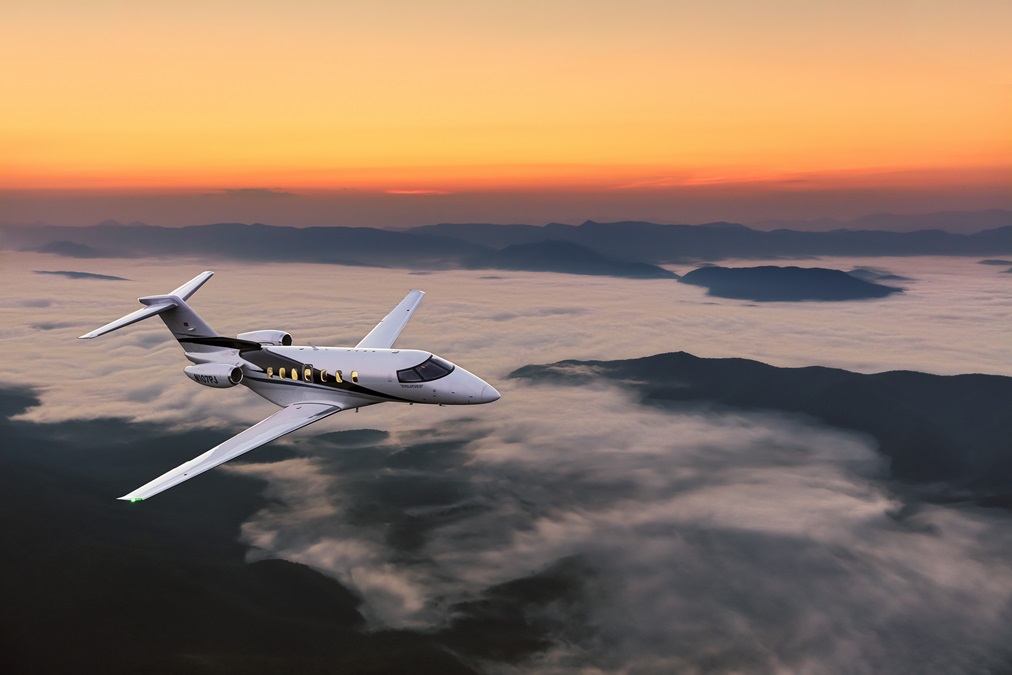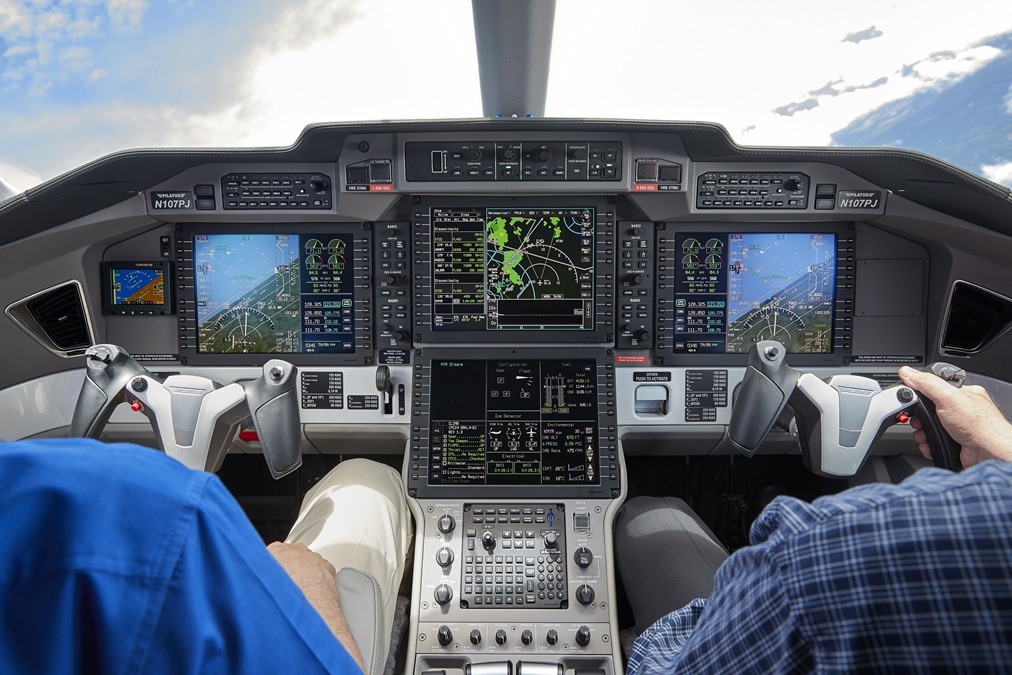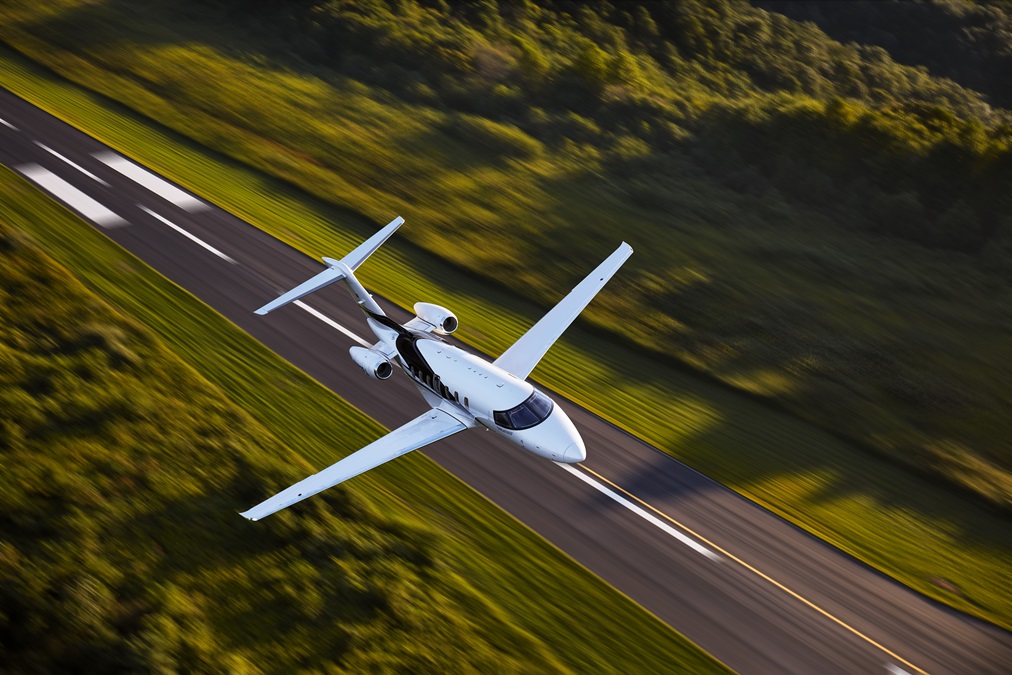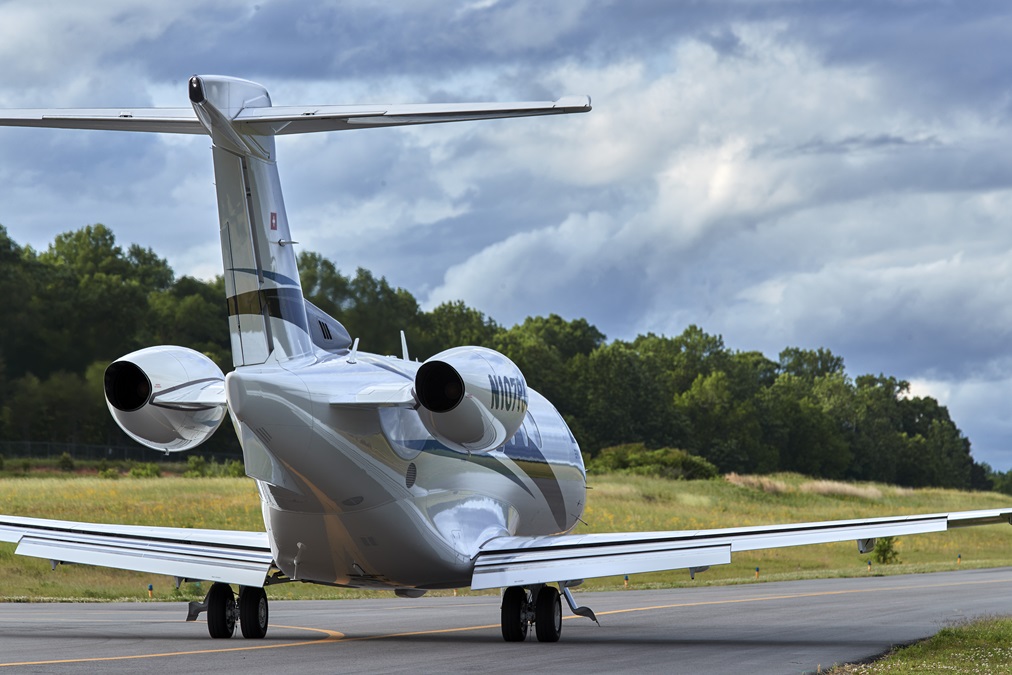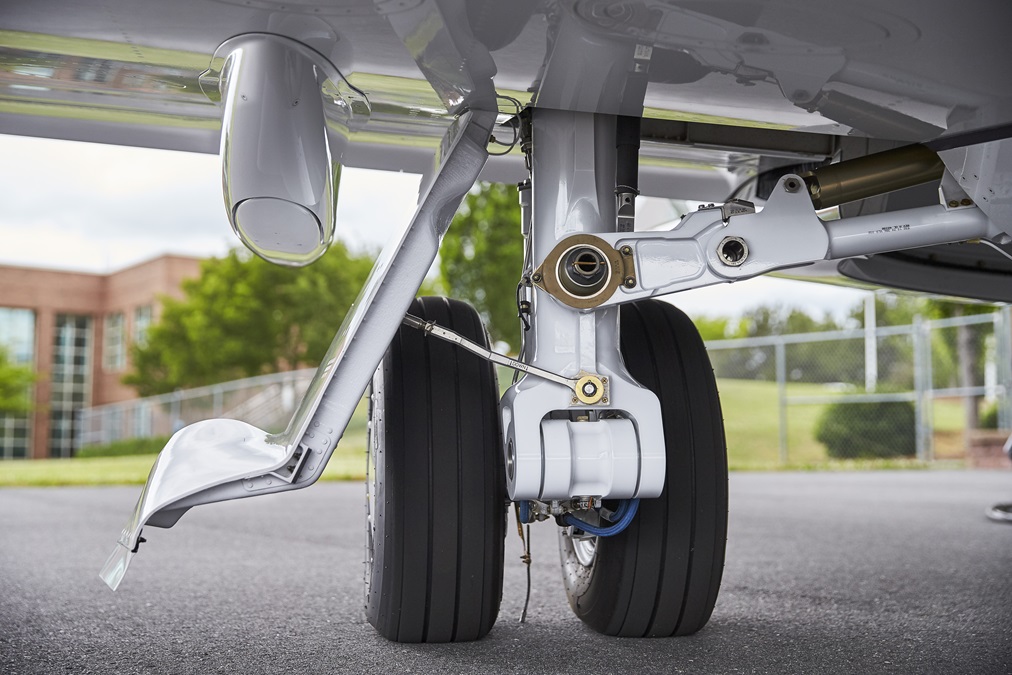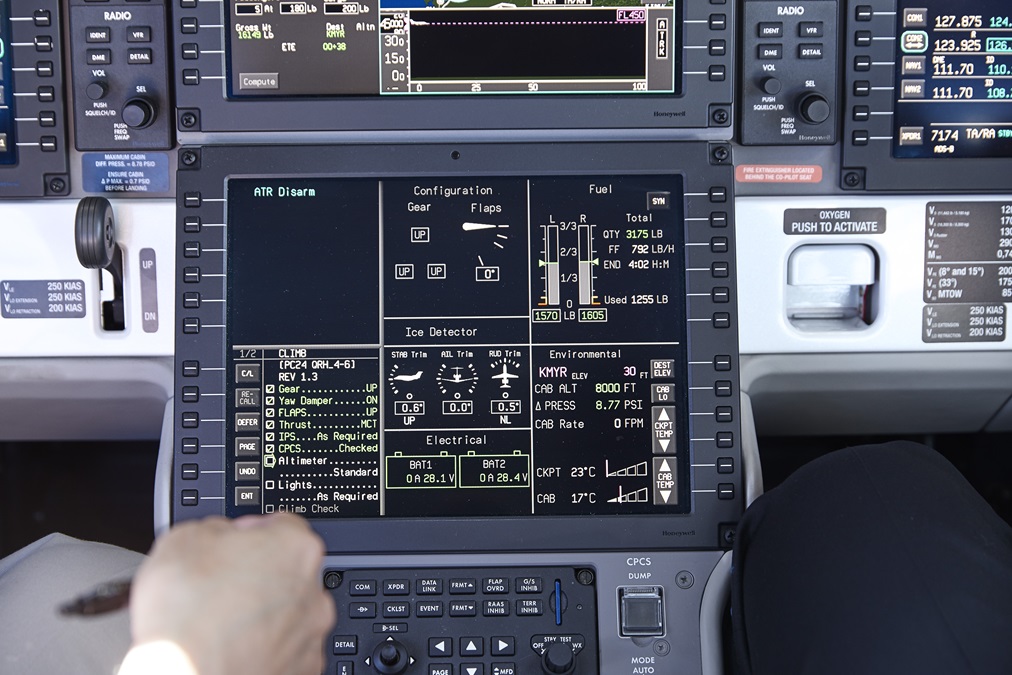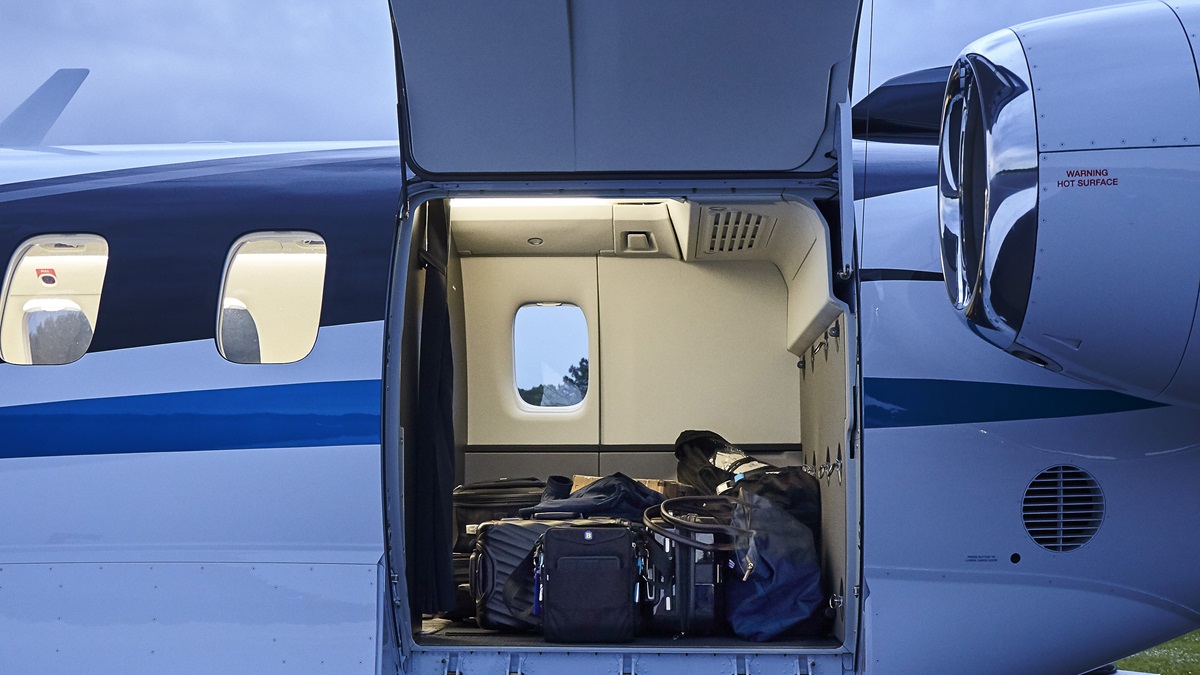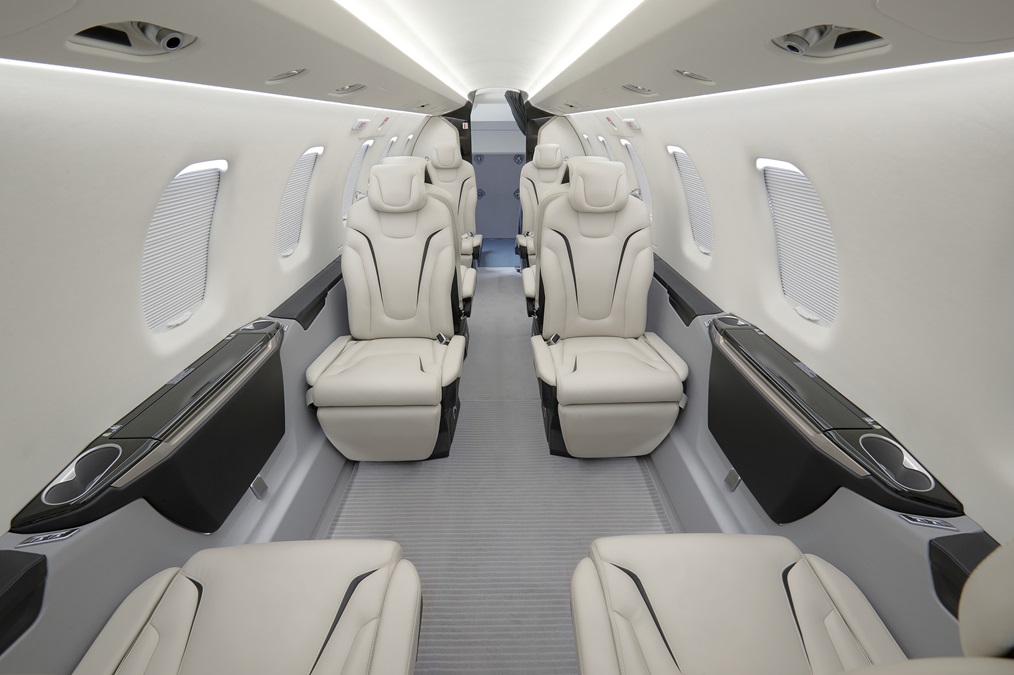Pilatus PC-24: Class Standout
Go fast, land slow—and carry a big load
But what kind of jet? The design challenge was to build a 425-knot, single-pilot twinjet with low landing speeds and good short-field performance, able to land on unimproved strips, and retain other signature features that had come to define the Pilatus brand: an airstair door up front, a huge aft cargo door, and an interior that could be configured to carry both passengers and cargo in varying proportions.
By 2009, the design work for what came to be known as the PC–24 was finished, and the first of three prototypes began a 3,000-hour flight test program. In 2014 Pilatus opened its order book, selling 84 PC–24s within 36 hours. This amounted to three years’ worth of production, enough that Pilatus stopped taking orders—for the time being.
As expected, there were fleet buys from fractional operators who already owned PC–12s—Portsmouth, New Hampshire’s PlaneSense, and Luxembourg’s JetFly, as well as orders from Australia’s Royal Flying Doctor Service. Among a mixture of other customers, 71 PC–12 owners stepped up to buy PC–24s.
Size, lift, and power
It’s tempting to think of the PC–24 as a PC–12 with jet engines, but that’s too simplistic. The PC–24 is a clean-sheet design, with many noteworthy features. Yes, the fuselage and doors appear to be the same as a PC–12’s, but that’s about where any similarities end. First of all, the PC–24 is larger, with 3 feet more wingspan and height; and a cabin 6 feet longer, 5 inches higher, and 7 inches wider.
The PC–24’s supercritical wing is key to the airplane’s versatility. To maximize its high speed (maximum cruise speed is 440 KTAS) and handling characteristics at altitude, the wing is a blend of five different airfoil profiles along its span. It’s a very clean wing, with no fences, vortex generators, cuffs, or slats. What’s more, each wing skin is milled down from solid, 3,975-pound billets of aluminum into single sheets weighing 185 pounds, so there are no seams or rivets. To keep landing speeds and distances slow and short, there are double-slotted flaps and a lift-dump system that automatically extends the airplane’s four multifunction spoilers and ground spoilers when the main gear touch down.
Power comes from two 3,420-pounds-static-thrust Williams FJ44-4A turbofans, which produce enough thrust for breathtaking initial climb rates and deck angles, and allow direct climbs to FL450 in 25 minutes under standard conditions. A big part of the reason for the initial climb performance has to do with what Williams calls its Exact nozzle. In plain language, there’s a 3-degree curvature in the engine’s exhaust duct that vectors thrust upward at lower airspeeds and high thrust settings. A strategically placed bulge in the duct creates a Coanda effect that accelerates the exhaust stream. The effect is to promote a nose-high moment that shortens takeoff runs and boosts climb rates. It’s a passive system with no moving parts, and it works. More on this shortly.
The Williams mounted on the right side of the PC–24 has an additional feature, a Quiet Power Mode (QPM) that acts as an auxiliary power unit (APU). Pilatus wanted to free the PC–24 of the need for ground power units but didn’t want to saddle the airplane with a heavy, expensive conventional APU. QPM lets you run the right engine at a low, sub-idle power setting—a less noisy 45-percent N2—with the press of a line select key on the primary flight display. Thanks to new, more efficient brushless generators, the lower QPM setting produces 250 amps—enough power to run the vapor-cycle air conditioning, cabin heat, and avionics while parked. To start the left engine, you need to press the key again to toggle to the normal, 53.4-percent N2 idle setting. For the first start of the day a GPU or the ship’s battery power must be used.
Up the stairs and turn left
Pilatus and its oldest distributor, Skytech Inc.—with full-service facilities at Westminster, Maryland’s Carroll County Airport and Rock Hill, South Carolina’s Bryant Field—gave me the chance to fly the PC–24, and it was an eye-opener. The cockpit, based on Honeywell’s Epic version 2 avionics suite and called the Advanced Cockpit Environment (ACE), is as full-featured as the Falcon 8X’s EASy cockpit I flew last month (see “FalconEye Flying,” June 2019 AOPA Pilot). That’s because they basically share the same Honeywell architecture. The layouts of the four massive display screens are the same, and so are other elements, such as the trackball, point-and-click cursor-control devices, the multifunction keypad, the autothrottles, and other touches.
After calling up the electronic checklists, Skytech chief pilot Steve Willis and I entered flight plans and clicked through each checklist using a yoke-mounted switch until we reached the last of the pretakeoff items. The neat thing about the electronic checklists is that when system checks are called up, the synoptics for each system automatically come up on the lower multifunction display.
Line up, verify that takeoff configuration is correct, stand the throttles up halfway, wait for the autothrottles to take over, and hang on. Once the Williams engines spooled up, the ship and its four passengers quickly blew through the 95-knot V1 and I pitched up into the command bars for the V2 of 104 knots, then the VT (final takeoff target speed) climb of 170 knots. Rock Hill’s Runway 20 was receding fast as we launched into the sky at a 20-degree deck angle, pressed back in our seats by the 3,300-fpm climb rate—and, presumably by that Coanda effect. An iPad did a sprightly slide from cockpit to the baggage compartment bulkhead. This was with a takeoff weight of 17,393 pounds—just 907 pounds shy of the PC–24’s 18,300 maximum takeoff weight.
“And this is at 170 knots,” Willis said. “You can climb out at the FMS-generated profile speed of 150 knots up to 2,500 agl, but that gives a really high deck angle and some passengers don’t like that. So most of the time I go to 170, then 200 knots in the climb, which is the autothrottle flight management system mode’s default climb speed up to FL230.”
By the way, assuming you lost an engine at V1, one-engine-inoperative climbs run around 900 fpm at high takeoff weights, assuming you fly at 170 knots after using initial climb speeds of V2, then 130 knots (but no less than V2 plus 25 knots) for flap retraction. For extra power during engine-out climbs, an automatic thrust reserve (ATR) thrust lever detent gives you 180 more pounds of thrust from the good engine. There’s a 10-minute limitation on ATR in engine-out situations, and a five-minute limitation for all-engine cases such as windshear encounters.
If there’s anything quirky about takeoff it’s the two-step pitch-up at VR. At rotation, pull the yoke to a mid-position after liftoff, then exert a little more aft stick force to match the nose with the command bars. Speaking of the yoke, I was told its modified ram’s horn design was inspired by the ergonomics used in video-gaming controls.
Several manual autothrottle speed selections were made in the climb before we let the FMS control it with its Mach 0.59 default speed passing FL340; the resultant climb rate was 2,200 fpm under ISA +11-degree conditions. In all, it took us 30 minutes to reach FL450, the PC–24’s maximum operating altitude. That’s about five minutes longer than the advertised time to climb, a discrepancy explained by our taking a timeout to do some turns for the camera. As we approached FL450 the airplane was still climbing at 600 fpm, even though ISA +10 conditions prevailed.
Once set up at maximum cruise power—using the maximum continuous thrust throttle detent—I wrote down the numbers: 410 KTAS, or Mach 0.73 (MMO is Mach 0.74); 416 pounds per hour (62 gph) per side fuel burn; and a static air temperature of minus 68 degrees Celsius, which is ISA +10 degrees. With this setup we could have flown approximately three more hours, and covered some 1,100 nautical miles.
During the descent to FL290, I had a chance to use the speedbrakes. Although they were very effective at slowing our speed and increasing the descent rate, there was little of the airframe rumble that usually occurs with other speedbrake-equipped airplanes. FL290 is the sweet spot for cruise speed, by the way. It was at this altitude that we saw 441 KTAS, or Mach 0.73, burning 866 pph/129 gph per engine—again, with ISA +10 conditions.
Like the PC–12 models, the PC–24 is equipped with a stick shaker/pusher stall protection system. Once we reached 15,000 feet I slowed the airplane and held the yoke back until the shaker went off as the airspeed slowed into the red band. Lower the nose a tad, add power, and you fly right out of shaker and begin building airspeed quickly. We put off the pusher demonstration until there was a flight with no passengers. The push is aggressive, so anything not strapped in is likely to go negative.
My approaches and landings were at Myrtle Beach, South Carolina’s International Airport and Manning, South Carolina’s Santee Cooper Regional Airport. The drill is to slow in stages from 180 knots to 150 knots/flaps 8 degrees, then 135 knots/flaps 15 degrees by the final approach fix (or rolling out on final for VFR landings) when the gear are lowered and flaps go to the full, 33-degree setting. I flew 110 or so knots down final, then slowed to the VREF of 98 knots until bleeding that off just above the runway. The wing is very slippery and the landing attitude flat, so it took a few landings to get things wired. I got a couple of wing rocks in the gusty conditions, but, believe me, once the weight’s on the mains and all those spoilers come up it’s an easy matter to stop the airplane in a very short distance. At 3,600-foot-long Santee Cooper the landing distance was an estimated 2,500 feet.
For all its size and weight, the PC–24 handles nimbly, and with a little practice you can rack the ship around in VFR pattern work like a much smaller airplane. My guess is that after a few hours most pilots with turbine time will easily master the airplane’s flight and landing procedures. It’s coming to terms with the ACE avionics that will be a bigger challenge. PC–12 pilots stepping up to the PC–24 will have a huge advantage here—because the Honeywell Epic platforms are the same in both airplanes.
Market perspective
The PC–24 is a breakthrough airplane that offers big-jet features such as autothrottles, single-point refueling, dual wheels, ground spoilers, an APU function, a flat floor and wide cabin—and, yes, an externally serviced vacuum-flush toilet in a hard enclosure. Then there’s the versatility to both cruise fast and use short, unimproved runways. That big aft door and flexible cabin configuration doesn’t hurt, either. All of this in an airplane that stays below the magic, 20,000-pound maximum gross takeoff weight breakpoint, that separates “light” jets from the mid-size category. The PC–24’s competition has been identified as Embraer’s Phenom 300, Textron/Cessna’s Citation 4, and the King Air 350i, among others—but none of them can carry big loads fast, let alone land on dirt.
PC–24s were priced at $8.9 million, but many owners bought options that pushed that number higher. At this year’s European Business Aviation Convention and Exhibit (EBACE) Pilatus announced a price hike to $10.1 million. They also cracked open that order book again and expected 60 more orders. That could be a conservative number. After all, the company anticipated the PC–12’s production run at 200 airplanes. Instead, PC–12 deliveries are now up to 1,600, and counting. Next it could be the PC–24’s turn.AOPA
Email [email protected]

